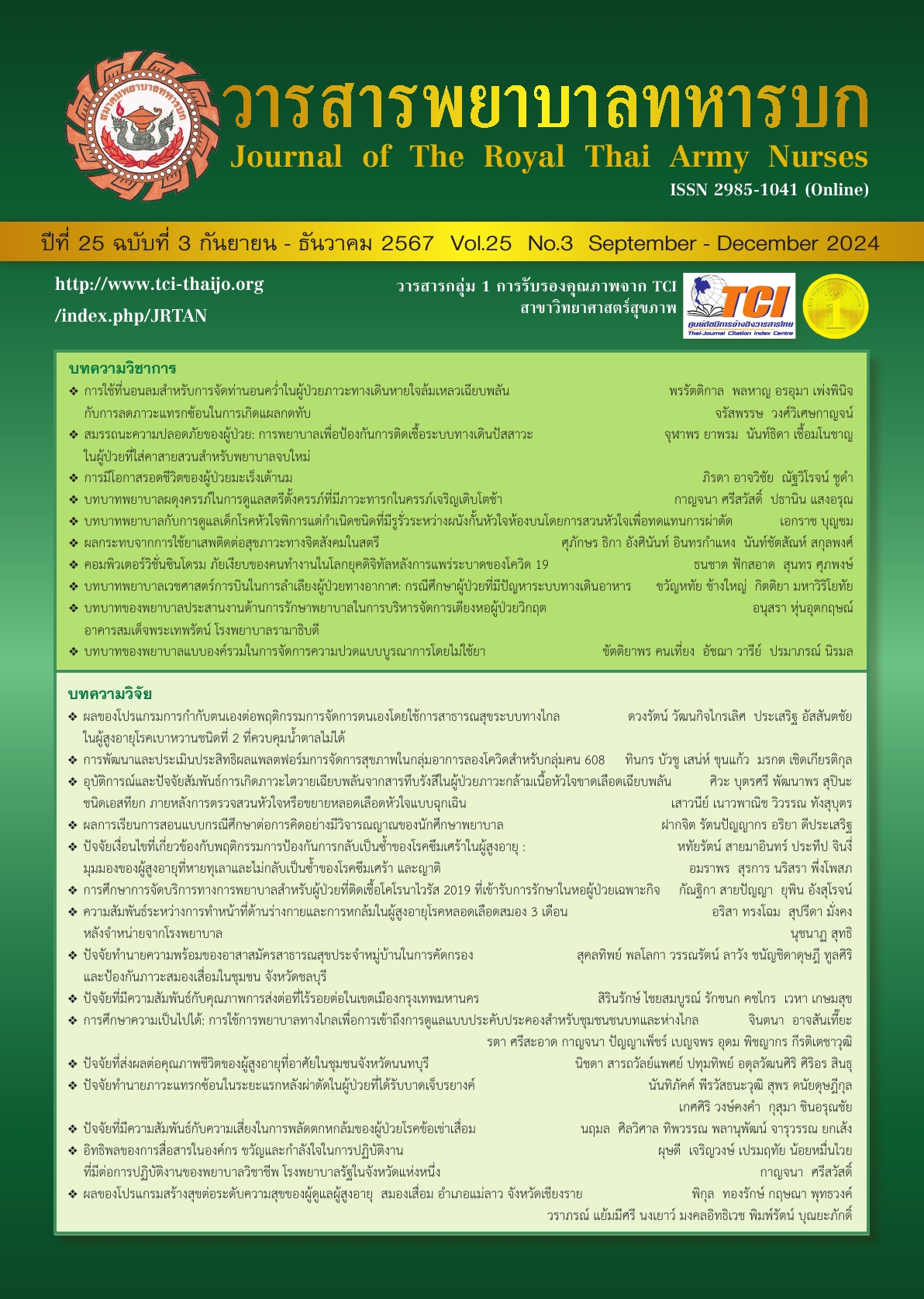The Use of Air Mattresses for Prone Position in Acute Respiratory Distress Syndrome Patients reduces Complications in Pressure Injury
Keywords:
Prone Position, Pressure Injury, Air MattressAbstract
Acute respiratory distress syndrome (ARDS) is a critical condition of the respiratory system that can occur from many causes. The main cause is infection. When patients have ARDS, it results in a higher mortality rate. Although nowadays there are more type of treatments available. Hight technology is being used for treatment, such as extracorporeal membrane oxygenation (ECMO). However, ECMO is still a highly expensive procedure and only be done in some hospitals. Prone position is therefore still one of the important standards for treatment and reduce the mortality rate of ARDS patients, can be done in every hospital. Although the prone position has benefits, high risk complications such as airways-related complications, pressure injury, facial and ocular edema, dislodgement of catheters and hemodynamic is unstable often arise with the prone position. Pressure injury is an important problem causing ongoing complications such as infection of the wound or chronic wounds occur, causes of larger wounds that can lead to loss of organs. The purpose of this article is to present the prevention of pressure injury in patients treated by the prone position. Using innovation and technology that reduces pressure with a sensor system, air mattresses for prone positions to reduce the risk of pressure injury
Downloads
References
Arabi Y, Arroliga A, Bernard G, Bersten A, Brochard L, Calfee C, et al. A New Global Definition of Acute Respiratory Distress Syndrome. American Journal of Respiratory and Critical Care Medicine, 2024.
Diamond M, Peniston HL, Sanghavi DK, Mahapatra S, Doerr C. Acute Respiratory Distress Syndrome (Nursing). Island: StatPearls Publishing; 2023.
Parcha V, Kalra R, Bhatt SP, Berra L, Arora G, Arora P. Trends and geographic variation in acute respiratory failure and ARDS mortality in the United States. Chest journal. 2021;159(4): 1460-72.
Huang X, Zhang R, Fan G, Wu D, Lu H, Wang D, et al. Incidence and outcomes of acute respiratory distress syndrome in intensive care units of mainland China: a multicenter prospective longitudinal study. critical care journal. 2020;24(1):515. doi: 10.1186/s13054- 020-03112-0. PMID: 32819400; PMCID: PMC7439799.
Qadir N, Sahetya S, Munshi L, Summers C, Abrams D, Beitler J, et al. An update on management of adult patients with acute respiratory distress syndrome: an official American Thoracic Society clinical practice guideline. American journal of respiratory and critical care medicine 2024;209(1):24-36.
Gattinoni L, Brusatori S, D’Albo R, Maj R, Velati M, Zinnato C, et al. Prone position: how understanding and clinical application of a technique progress with time. Anesthesiology and Perioperative Science Journal. 2023;1(1): 1-17.
Pérez-Juan E, Maqueda-Palau M, Feliu-Roig C, Gómez-Arroyo JM, Sáez-Romero D, Ortiz-Monjo A. Incidence of pressure ulcers due to prone position in patients admitted to the ICU for Covid-19. Enfermería Intensiva (English edition) Journal. 2023;34(4):176-85.
McEvoy NL, Friel O, Clarke J, Browne E, Geoghegan P, Budri A, et al. Pressure ulcers in patients with COVID-19 acute respiratory distress syndrome undergoing prone positioning in the intensive care unit: a pre-and post-intervention study. Nursing in Critical Care Journal. 2023;28(6):1115-23.
Binda F, Galazzi A, Marelli F, Gambazza S, Villa L, Vinci E, et al. Complications of prone positioning in patients with COVID-19: a cross-sectional study. Intensive and Critical Care Nursing Journal. 2021;67(1):1030-88.
Aimmak B, Nuekwen P, Khanacharoen S, Homjeen T. The Development of Clinical Nursing Practice Guidelines for the Prevention of Complications from Prone Position in Patientswith Acute Respiratory Distress Syndrome. Rajavithi Hospital. Vajira Nursing Journal. 2022;24(1):51-66. (in Thai)
European Pressure Ulcer Advisory Panel (EPUAP), National Pressure Injury Advisory Panel (NPIAP), Pan Pacific Pressure Injury Alliance (PPPIA). Prevention and treatment of pressure ulcers/injuries: clinical practice guide lines. The international guideline. 3rd ed. Emily Haesler. editor. EPUAP, NPIAP, PPPIA; 2019.
Chaiyara S, Nadsantia P, Srithong I, Sirimontri J. The Development of Nursing System for Critical ill patients with covid-19 at Sakon Nakhon Hospital. Journal of The Royal Thai Army Nurses. 2023;24(2):435-45. (in Thai)
Prapainop K, Artsanthia J. Wound Care for Patients in Thailand 4.0 with Nanotechnology. Journal of The Royal Thai Army Nurses. 2017;18(3): 9-15. (in Thai)
Ketsamphan Y. From pressure ulcer to pressure injury: Etiology, definition and staging. In: Wongwisetkan J, Sinmaneerat C, Phumraya P, Chuangsawatsak S, editors. Pressure ulcer skin injury and chronic wound: nursing professional issues and opportunity in new ages: Ebook ; 2018. (in Thai)
Katz T, Gefen A. The biomechanical efficacy of a hybrid support surface in protecting supine patients from sacral pressure ulcers. International Wound Journal. 2023;20(8): 3148-56.
Misaki A, Imanishi K, Takasugi SI, Wada M, Fukagawa S, Furue M. Body pressure sensing mattress for bedsore prevention. SEI technical review Journal. 2014;78(1):95-9.
Kawabata T, Sugama J. Relationship between mattress internal air pressure and interface pressure distribution in the lateral position. International Wound Journal. 2022;19(8): 2115-23.
Downloads
Published
How to Cite
Issue
Section
License
Copyright (c) 2024 Journal of The Royal Thai Army Nurses

This work is licensed under a Creative Commons Attribution-NonCommercial-NoDerivatives 4.0 International License.
บทความหรือข้อคิดเห็นใดใดที่ปรากฏในวารสารพยาบาลทหารบกเป็นวรรณกรรมของผู้เขียน ซึ่งบรรณาธิการหรือสมาคมพยาบาลทหารบก ไม่จำเป็นต้องเห็นด้วย
บทความที่ได้รับการตีพิมพ์เป็นลิขสิทธิ์ของวารสารพยาบาลทหารบก
The ideas and opinions expressed in the Journal of The Royal Thai Army Nurses are those of the authors and not necessarily those
of the editor or Royal Thai Army Nurses Association.






